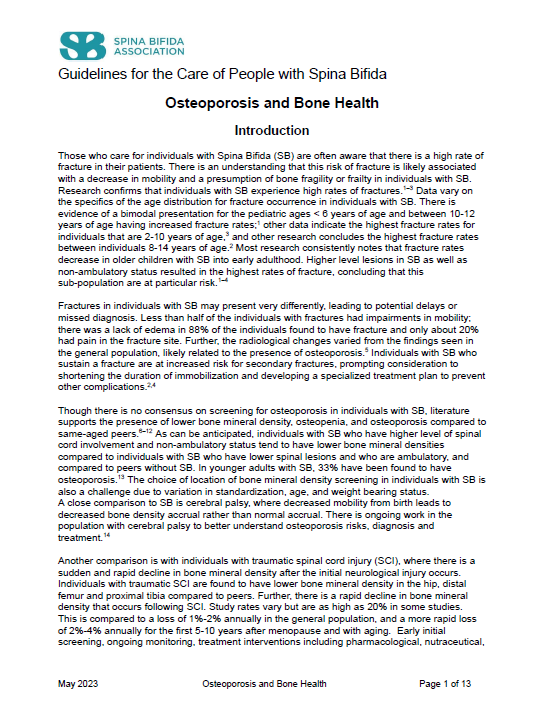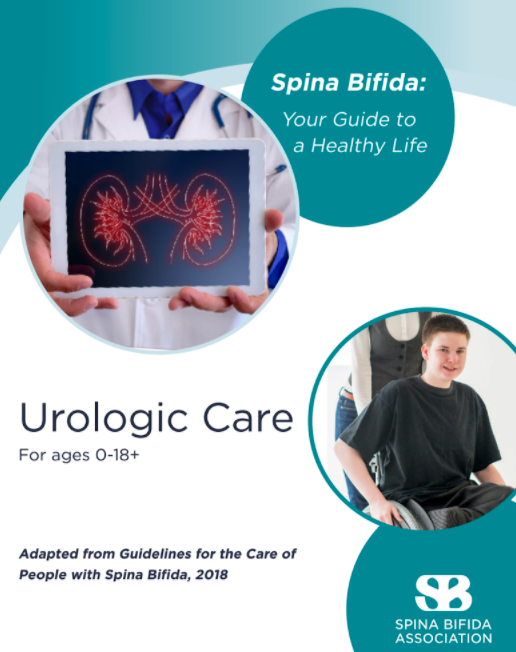The Spina Bifida Association (SBA) has identified the practices and processes that contribute to the best outcomes for people with Spina Bifida. We developed 10 standards for Spina Bifida Clinics to meet to become a Clinic Care Partner. SBA’s Professional Advisory Committee approved these 10 standards.
Standard 1: Your program delivers care to patients using the Guidelines for the Care of People with Spina Bifida.
Standard 2: The clinic must have a medical director from medical or surgical disciplines. If the medical director has a surgical background (e.g., neurosurgery or urology), the clinic must demonstrate partnership with a provider from physiatry or medicine (general pediatrics, developmental pediatrics, internal medicine, internal medicine/pediatrics, or family medicine) to ensure that the person’s comprehensive needs are met.
Standard 3: The clinic must have a clinical care team that consists of, at a minimum, a medical director and nurse or nurse practitioner.
Standard 4: The clinic care team collaborates with identified care providers such as orthopedic surgeons, neurosurgeons, urologists, neuropsychologists, physical and/or occupational therapists, social workers, nephrologists, gastroenterologists, dietitians, psychologists, wound care specialists, and others who have expertise and interest in comprehensively treating people using the Guidelines for the Care of People with Spina Bifida.
Standard 5: Care is coordinated and integrated for each patient, through designated personnel available five days per week, during regular business hours. In some practices, care coordination is shared among several staff members. If more than one person is named as a Care Coordinator, please describe the roles of each person.
Coordination of care includes, but is not limited to:
– Communication among providers of care, including the primary care physician, so that care planned and executed between the providers and the patient/family is integrated
– Creation of a written plan of care between the person with Spina Bifida, their family, and the health care team
-Follow-up on medical testing (scheduling tests, obtaining results, communicating results to the provider, and other relevant steps)
-Triage of patient calls
-Plan for inter-professional training with a Care Coordination Curriculum so that all members of the care team—including the patient and family—understand the importance of care coordination and why it is not the same as care provision
-Incorporation of performance measures of care coordination and care integration
-Development of a mechanism to receive and address urgent and emergency calls and care during non-business hours
Standard 6: The clinic engages in an activity that either promotes knowledge about the care of people with Spina Bifida, promotes the improvement of the care of people with Spina Bifida, or both.
Standard 7: If the clinic serves newborns, within one year of this application, the clinic has or will work to establish a relationship with prenatal Spina Bifida diagnosis programs, and consults with families to present the diagnosis in a standardized way.
Standard 8: The clinic agrees to create a Patient Advisory Committee, including patients and their families, and convene it within one year of this application. The Patient Advisory Committee will meet regularly with the support of the clinic and will advise the clinic of patient/family experiences and improvement opportunities. The Patient Advisory Committee should represent ethnic diversity, geographic distribution, and treatment modalities.
Standard 9: The clinic’s program for transition preparation and execution is documented within one year of this application.
Standard 10: The Spina Bifida Collaborative Care Network (SBCCN) works to improve the lives of people with Spina Bifida. This network includes people with Spina Bifida, clinics, health care professionals, SBA Chapters, and SBA. The clinic must demonstrate support for SBA through participation in at least two of the following activities every year:
-Use specific SBA resources and connect patients to them
-Provide a speaker for at least one SBA program
-Participate in a SBA committee or task force
-Participate in SBA activities such as Walk-N-Roll for Spina Bifida, Teal on the Hill, Awareness Month, Education Days, World Congress on Spina Bifida Research and Care, and Clinical Care Meeting
-Join SBA’s listserv for Spina Bifida health care professionals, or
-Engage in a similar activity that supports the SBCCN.

